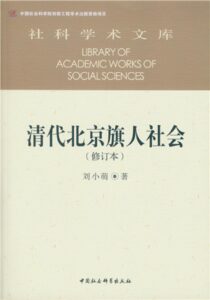
Liu, Xiaomeng 刘小萌
Beijing: Zhongguo shehui kexue chubanshe 中国社会科学出版社, 2008 (revised in 2016)
Reviewed by Minsu Park (Ph.D. Candidate, Seoul National University; 2015-16 HYI Visiting Fellow
The Society of the Bannermen in Beijing during the Qing Dynasty represents the height of research by one of the foremost Chinese scholars on the Manchu banner system, synthesized into a single monograph. In the afterword, the author tells the reader that his mother herself was a descendant of the bannermen, and confesses that he is a ‘half-bannerman’ of Beijing, thereby ending this work on a warm and personal note. It reads as though Liu’s lifetime of research on the Manchu people and Qing history—and the book itself—have been dedicated to his roots, the bannermen of Beijing.
Most noteworthy about this book is the way in which the author successfully explains the significance of the Beijing bannermen in the wider context of Qing studies, Manchu studies, and the urban history of Beijing. The main argument of Liu’s work is that the bannermen and civilians of Qing Beijing were engaged in a complex process of exchange, interaction and acculturation. Liu emphasizes the dual aspect of the banner system, showing how it served as the foundation upon which the identity of the Beijing bannermen was maintained, but also how it made the bannermen dependent on the surrounding civilian population. Particularly in a large city such as Beijing, the bannermen could not but maintain close contact with civilians in everyday life. As much as this was a systemic weakness built into the banner structure, it also enabled the long endurance of the limited but still significant separate ethnic Manchu identity. The exchange and interaction between civilians and bannermen was the most important aspect of bannermen culture in Beijing, and functions as the theoretical undergirding of this work.
Liu builds his work upon Manchu language sources, in addition to a host of materials including contracts, epitaphs, genealogies, personal writings, fiction, geography books, and visual and oral sources. Using this broad and unique documentary base, he provides an in-depth and systematic analysis of the bannermen society in Beijing. The length of his work, at more than a thousand pages, testifies to the depth and breadth of Liu’s research and its wide coverage of various sources. Liu also successfully combines the theories of ethnic studies and sociology, and connects traditional source-based historical research with his own fieldwork and interviews to broaden the scope of historical research.
The bannermen society of Qing Beijing was not merely a site of the new Manchu culture, nor was it a replica of previous Han culture. It was essentially a “melting pot” in the sense that it formed a place where different cultures were fused into one, but also represented a furiously active environment. Almost ten years have passed since its first publication, but The Society of the Bannermen in Beijing during the Qing Dynasty remains a classic in the field, and shows how the recent discussions over New Qing History in China still stand to benefit from the wealth of works that have already been published.
